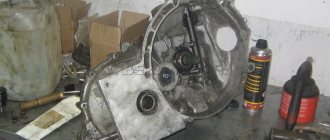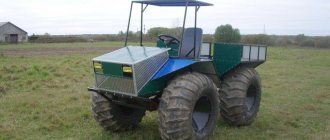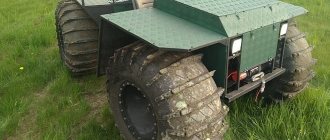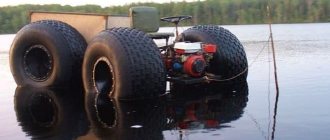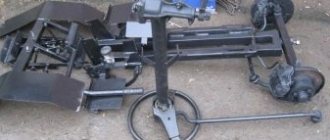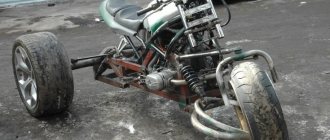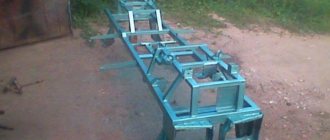Homemade all-terrain vehicle fracture 4x4 "Bukinda" with an engine from Oka: photos of the step-by-step construction of an all-terrain vehicle with a breaking frame, as well as a video of tests.
The author set himself the task of building an all-terrain vehicle for hunting and fishing, with an insulated kung and good cross-country ability; it was decided to choose a breakable frame as the basis for the design.
A breaking frame is a so-called “fracture”, it is a structure consisting of two parts that can move independently of each other; the connecting point is the breaking unit. Each frame has its own wheel pair; this design significantly increases the vehicle’s cross-country ability.
To build the homemade product, the author used:
- Engine from Oka.
- Axles and gearbox from VAZ - 2121.
- Axle cam and steering - UAZ.
- Frame made of profile pipe 50 x 20, 40 x 20 mm.
- Wheels "Trekol" 1300 x 600.
Photo of all-terrain vehicle assembly, broken on low-pressure tires.
The frame is made of profile pipe.
Installation of box and bridges.
Painting the frame of an all-terrain vehicle.
The engine, cooling system radiator, and steering column are installed.
After installing the wheels, the weight of the front trolley of the all-terrain vehicle is 500 kg, the rear one is 300 kg.
The body is covered with sheet aluminum, made of kung.
In the photo, the all-terrain vehicle fracture unit is made from the UAZ steering knuckle.
A winch is attached to the front bumper.
After assembly, the Perelomka all-terrain vehicle was immediately tested on a 140 km hiking route, loaded with two passengers and 200 kg of cargo. Over the entire route, 40 liters of gasoline were consumed.
During the testing process, the author discovered the following advantages and disadvantages. The all-terrain vehicle has good maneuverability, floats well on the water, but floats very slowly and more in the direction of the wind.
Without power steering, steering is quite tiring on long trips.
To get maximum cross-country ability of an all-terrain vehicle, you can experiment with wheels. In winter, the author installed rubber wheels 1300 x 530 x 533, but in deep snow the all-terrain vehicle on such tires gets buried. The best cross-country ability in the snow was shown by Trekol tires with a checker tread; tires with a herringbone tread skid.
Interesting video: overcoming a deep ditch, showing how the breaking frame of an all-terrain vehicle works.
On video: overcoming the swamp.
Dear visitors to the “ Samodelkin Friend ” website, today we will look at the step-by-step process of assembling a fractured all-terrain vehicle on Alexander Murashov’s wheels. Video of testing and photo of assembly is attached. This all-terrain vehicle has two semi-frames connected to each other by a steering knuckle from the front axle from the UAZ, and is driven by the steering control of the VAZ. The semi-frames are welded from square-section corrugated pipe, the rear part of the frame has a conical shape tapering to the junction with the steering knuckle - this is necessary to increase the steering angle. This frame layout is borrowed from the T-150 tractor, that is, the operating principle of the fracture.
What types of caracats are there?
Before figuring out how to independently make a karakat swamp rover from improvised mechanisms, it is necessary to take a closer look at the existing varieties of this kind of product. The Karakat swamp all-terrain vehicle is nothing more than a non-standard vehicle that moves with the help of wheels on which low-pressure tires are installed.
Among its main advantages:
- excellent maneuverability;
- low cost;
- maintainability;
- high power (depending on the spare parts used).
Such mechanisms are most often constructed independently on the basis of some equipment, for example, a tractor or walk-behind tractor. Existing models differ from each other not only in characteristics, but also in design. The most widespread are all-wheel drive and three-wheel drive devices.
All-wheel drive
All-wheel drive models seem to be the most popular transport option among consumers. They are equipped with 4 wheels, thanks to which the design is stable and has high maneuverability. Such a caracat can overcome even impressive obstacles without any problems, but its assembly will require two wheels of the same diameter.
To make such a swamp vehicle, the breaking with your own hands must be done correctly, otherwise there is a high probability of assembling an inoperable structure.
Three-wheeled
An equally popular modification can be considered models of swamp vehicles with three wheels. Such vehicles are lightweight and have the same cross-country ability as their all-wheel drive counterparts. Such an option will be optimal if you need to quickly make high-quality karakat. Do-it-yourself fracture can be done if you have the necessary equipment.
Stages of creating a homemade karakat
If you want to construct a Vologda swamp vehicle, the Karakat, or its other models at home, you should first of all purchase the necessary tools in advance, as well as acquire suitable components.
The complete list of necessary components and tools may vary and directly depends on the selected vehicle model that is planned to be manufactured. When analyzing the assembly process of such a product, it is necessary to highlight several important stages:
- Selection of the frame of homemade tractors or motor vehicles, which will become the basis of the future device.
- Planning and assembly of the rear axle and vehicle suspension.
- Selection and installation of suitable wheels.
- Installation of the power unit.
Since these types of elements seem to be key in the design of a swamp vehicle, it is advisable to consider the features of their selection and installation in more detail.
The main structural element is the frame, on which other components and assemblies will be installed in the future. Its choice directly affects the appearance of the future caracat, as well as its performance characteristics. Experienced craftsmen recommend using the frames of old domestically produced motorcycles, for example, IZH or Ural, since it is much easier to make a karakat from a motorcycle than from a car.
Spare parts from them are characterized by low cost, high strength and optimal characteristics for use as the basis for a swamp vehicle. After all, such three-wheeled models boast high maneuverability and maneuverability, which makes them universal. During the manufacturing process, it is advisable to use a frame drawing due to the complexity of the assembly.
Suspension
When designing the chassis, it is strongly recommended to give preference to an independent type of suspension. This is due not only to the ease of its manufacture, but also to its excellent characteristics.
If the user does not have the ability to implement independent suspension, standard pneumatic wheels can be used.
Wheels
The choice of wheels for a future swamp vehicle must be given special attention, since its maneuverability, as well as ease of operation, depend on this. Large wheels from high-power trucks are perfect for this type of use.
Low-pressure chambers are used throughout, allowing the all-terrain vehicle to overcome even large obstacles. If desired, you can make karakat discs, which will significantly improve the appearance of the structure. It should be remembered that for pneumatic tires it is necessary to use only truck tire tubes, and not the wheels themselves.
Engine
After the installation of the wheels has been completely completed, you should begin installing the engine, as well as the accompanying mechanisms necessary for the correct movement of the vehicle. As mentioned earlier, it makes sense to give preference to powerful units equipped with liquid and air cooling. A good option could be a product with a Lifan engine.
Video selection
Karakat-all-terrain vehicle based on the Neva walk-behind tractor:
A lightweight all-terrain vehicle with the working title “Bruise”, as the body is sheathed in polycarbonate. In general, this is the first model where this light, warm and more or less durable material was used. So far there are no complaints about polycarbonate, this plastic should withstand frosts of up to 40 degrees and does not deteriorate in the sun, most importantly, it is much lighter than any iron and aluminum and cheaper.
The all-terrain vehicle turned out to be quite light for its size, capacity and large wheels. Approximate weight is about 600kg. Dimensions: length-3400 mm, width-1960 mm, cabin height 2100 mm, kung height 2350 mm.
Technical characteristics of the all-terrain vehicle
Rotation method
— “fracture” of the frame on the UAZ fist Wheel
formula
— 4x4, permanent all-wheel drive
Dimensions
— L*W*H /3400*1960*2350
Curb weight
— 650 kg
Load capacity
— land/water 300/150 kg
Maximum speed
— land/ water 25/1 km/h
Engine
- IZH-Planeta3, converted to liquid cooling
Chain gear
- chain pitch 19.05 mm, gearbox inverter = 2.13
Drive axles
- M-412, main pair inverter = 3.9
Tires
- Bel -79 1020*420-18, chamber
Discs
- homemade
Frame
- spatial, welded, made of profile pipes
Cabin
- semi-closed, single-seat
Body
- semi-closed, lined with polycarbonate
The all-terrain vehicle was built as a simple and budget option. The engine was planned from the SZD motorized stroller, but the Soviet heritage remains less and less and now it is difficult to find old engines and other elements as people sell everything for scrap. But we still managed to find other necessary parts for the “planetary” engine. The engine turned out to be prefabricated, based on Planet 3, but with the right half replaced for a 12-volt generator.
Reworking a walk-behind tractor
Walk-behind tractors are rightfully considered one of the most versatile types of agricultural machinery, which is why they are often used as the basis for various home-made units. Among them, homemade 4×4 mini tractors with a breakable frame are very popular, as well as caracats made from a walk-behind tractor, which are in no way inferior to other types in terms of technical performance.
To successfully manufacture such a device from a walk-behind tractor, you will need to follow the following instructions:
- Weld the frame using a metal profile/pipe.
- Mount rear and front drives. To simplify the process, it is recommended to take the front axle, steering system, and other elements from the vehicle’s chassis.
- Install the motor, as well as the gearbox included in the design of the walk-behind tractor.
- Construct and secure the slopes, and then roll in the resulting structure.
It is important to note that for this type of swamp vehicle it is recommended to use a wheelbase with increased belt-type traction. Structures made from walk-behind tractors, as a rule, have impressive dimensions and can reach speeds of up to 70 km/h, which makes them universal and reliable off-road solutions.
In order for the karakat to have the necessary characteristics, it is necessary to use high-power walk-behind tractors, since the vehicle must not only move successfully, but also transport the driver, as well as various loads.
DIY swamp vehicle master class on how to make one from Serov
It's me, Sergey.
I live in a small town in the north of the Sverdlovsk region. I am fond of hunting and fishing, I have favorite places for these purposes, but getting to them on foot is not possible. And it’s not always possible to carry the results of fishing on yourself. Therefore, we need equipment that can drive off-road in any weather and with a load of up to 300 kg.
I had an old all-terrain vehicle, but it was rather weak and, having been so old, it was already starting to fall apart. I decided to make a new swamp rover with my own hands, reliable and powerful. Preparation for construction turned out to be much longer than the assembly itself. It was necessary to purchase a bunch of components and assemblies, but there was no money for them. I had to collect from what I had and what I could find for little money.
The principle of the all-terrain vehicle will be a tricycle. Why a tricycle? Because it is more maneuverable in the forest and in swampy areas. The engine will be from a disabled woman, the wheels will be from a T-150 Tractor. Frame from a motorcycle Izh. Damper from GAZ53, axle shafts from GAZ 66
So, we have all the components prepared, let's start assembling the trike.
We install the frame, by the way the frame is from an Izh motorcycle. Why from Izha? Because the engine will be an IZH, there is no need to redo the mount and the frame is quite strong in itself.
And we weld the frame of our all-terrain vehicle to this frame. The frame is made of pipes with a diameter of 40 and 32, ordinary, not thick-walled. In the center is corner 63. We try on the rear axle.
Next we assemble the fork. Homemade fork. Steering column with tapered bearings. The fork itself is made from the same pipe as the frame.
As you can see, we have already started installing the engine. The engine, as I already wrote, is from a disabled woman. It is good because it has forced cooling and an electric starter.
- To reduce the speed and increase the traction of the all-terrain vehicle, we do a double chain reduction.
- Photo 14
- Installing the rear axle.
- We make a rigid frame for the swamp vehicle and install the entire transmission.
- Well, we put the all-terrain vehicle on wheels
Next we work with the wheels, we need to lighten them, because... The weight of the swamp vehicle itself is not large, so wheels of such mass are not needed. We tear off the excess rubber.
We will also lighten the rims for the swamp vehicle wheels. We will make them detachable so that the tire does not become beaded. To do this, we cut out windows in them. Assembling the wheel.
The seat was installed from a Voskhod motorcycle because... it was available. To install this seat, we had to take part of the frame and weld it from the same Voskhod. The battery was temporarily tied with wire for a test run)
We also make fenders for the rear wheels from scraps of corrugated board. Wings are definitely needed, because... We will drive mainly on mud.
Well, between the rear wings we are making a box in which we will carry things and crafts. A toolbox was made behind the seat behind the seat.
That's it, the all-terrain vehicle is ready for off-road travel. Now is it clear how to make an all-terrain vehicle with your own hands? As you can see, from old things with minimal costs and skillful hands you can make a worthwhile thing that will serve you for many years.
Sergey liked the process of assembling the all-terrain vehicle so much that he decided not to stop, sell this all-terrain vehicle to purchase new spare parts and begin manufacturing a new one, based on the GAZ 66. So those who wish to purchase this all-terrain vehicle can contact the author by phone. +79506442023
The price of this all-terrain vehicle is 70 thousand. rub. Delivery to other regions is negotiable.
Well, stay tuned, Sergey, we hope he will please us with more of his homemade products from old motorcycles.
